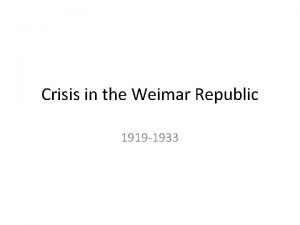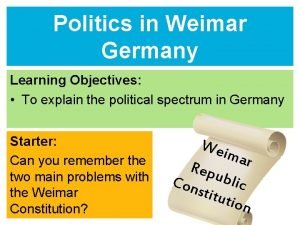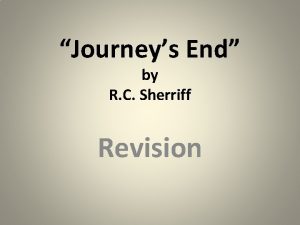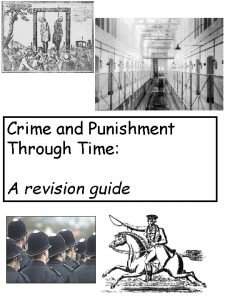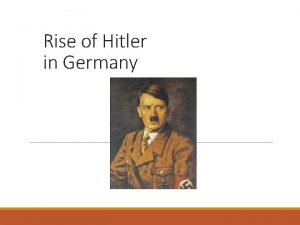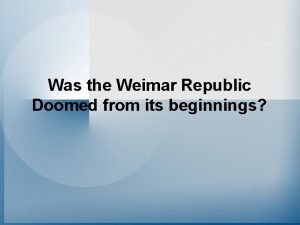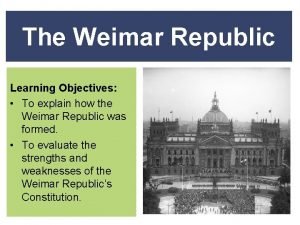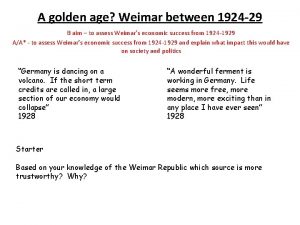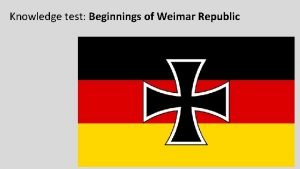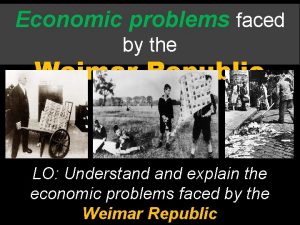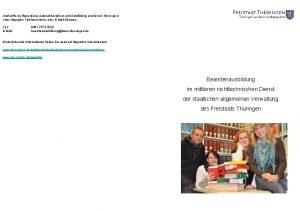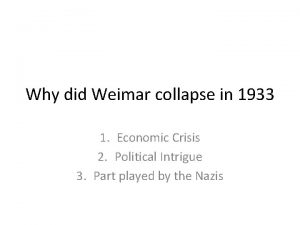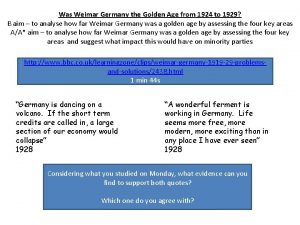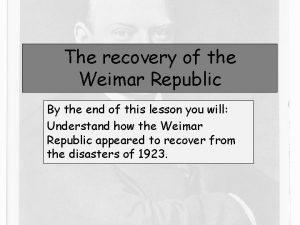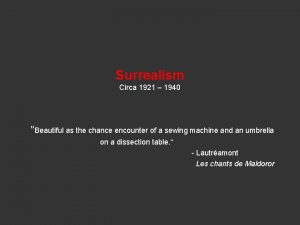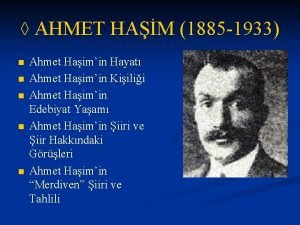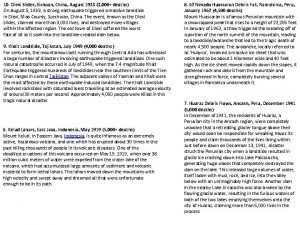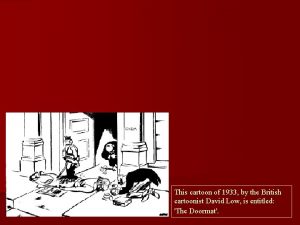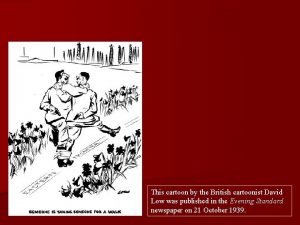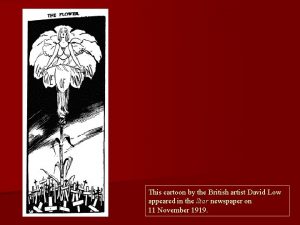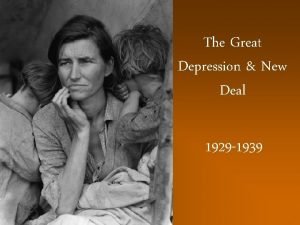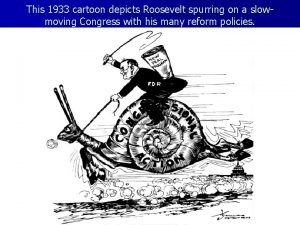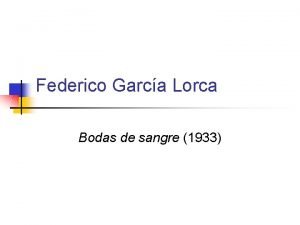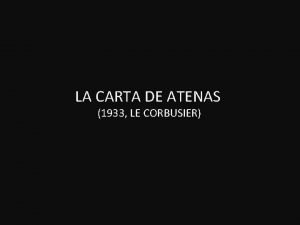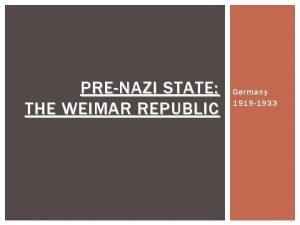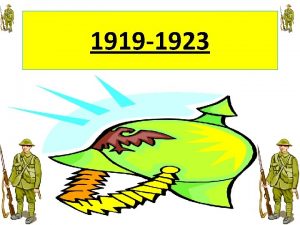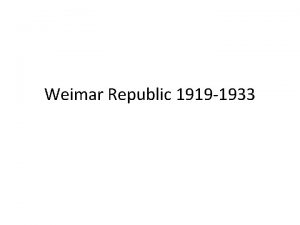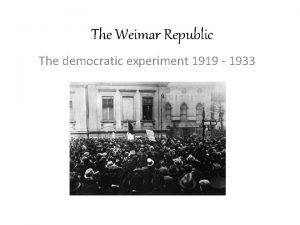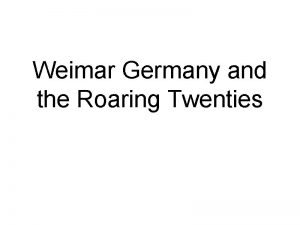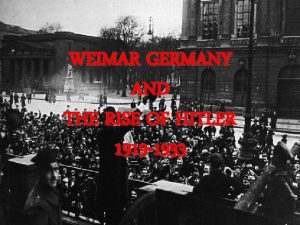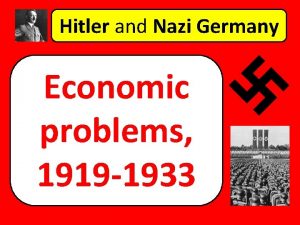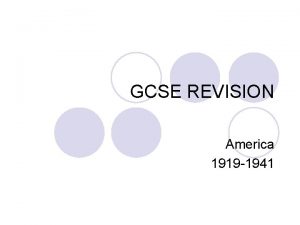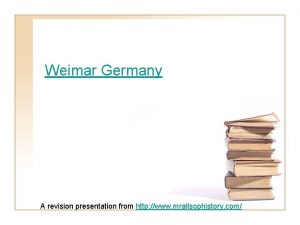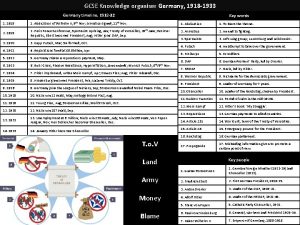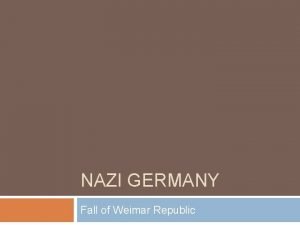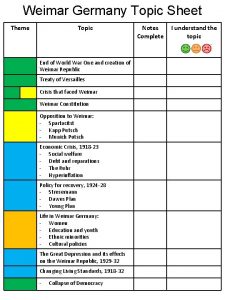Weimar Germany 1919 1933 Revision Guide Contents End






































- Slides: 38

Weimar Germany 1919 – 1933 Revision Guide

Contents • • • End of WW 1 – questions – answers Spartacist Revolution – questions – answers Weimar Constitution 1 – questions – answers Weimar Constitution 2 – questions – answers Treaty of Versailles – questions – answers Other Opposition – questions – answers Beginnings of the Nazi Party – questions – answers 1923: A year of Crisis 1 – questions – answers 1923: A year of Crisis 2 – questions – answers 1924 – 29: Economic boom – questions – answers 1929: Economic bust – questions – answers 1929 – 33: Rise of the Nazis – questions – answers

Read this. . . End of WW 1 • Germany was in a very poor state: – – the blockade of Germany had lead to a lack of food and supplies People were starving Riots were breaking out The navy had mutinied against the Kaiser • The Kaiser realised the situation was hopeless and abdicated in October 1918. Germany was left without a leader and in a mess • The biggest political party in Germany was the Social Democrats. Their leader, Friedrich Ebert, took on the job of running Germany. He tried to improve people’s lives by giving them better working conditions and freedom of speech Then click here. . .

End of WW 1 Answers. . . 1. What had happened to Germany to leave it’s people starving? 2. What was breaking out in towns and cities? 3. Who had mutinied against the Kaiser? 4. When did the Kaiser abdicate? 5. Who was the biggest political party in Germany? 6. Who was their leader? 7. What did he promise the people of Germany?

End of WW 1 1. 2. 3. 4. 5. 6. 7. Britain had blockaded it’s ports Riots The navy October 1918 Social Democrats Friedrich Ebert Better working conditions and freedom of speech Back to contents

Read this. . . Spartacist Revolution • In January 1919, the German communist party (the Spartacists) decided that they wanted to take over Germany from Ebert • They started a revolution attempt on 6 January. It was not successful – in a week, Ebert with the help of his Freikorps (ex-WWI soldiers paid to help the government keep order) had stopped the rebellion and killed many communists • The Spartacist leaders, Rosa Luxemburg and Karl Liebnecht, were murdered • It was helpful for Ebert that the Spartacists were no longer a threat • However, he had to rely on the Freikorps to keep order – that made him look weak to the public, and it was risky as Then click the Freikorps could turn on him at any point here. . .

Spartacist Revolution 1. 2. 3. 4. 5. 6. 7. Answers. . . When was the Spartacist Revolution? What political ideology did they believe in? Who did Ebert use to help him? Who were the leaders of the Spartacists? What happened to them? How was the Revolution positive for Ebert? What weaknesses did it show?

Spartacist Revolution 1. 2. 3. 4. 5. 6. January 1919 Communism The Freikorps (right wing ex-WW 1 soldiers) Rosa Luxembourg & Karl Liebknecht They were both murdered The Spartacists were no longer a threat; showed decisiveness 7. He had to use the Freikorps; made him look weak; Freikorps could turn on him Back to contents

Read this. . . Weimar Constitution 1 • The Social Democrats won the January 1919 elections • They held the first meeting of their new government in a town called Weimar – and got the nickname “The Weimar Government” • Their first job was to write a new constitution for Germany • Their new rules included everyone over the age of 20 could vote people voted for MPs who would sit in the Reichstag would suggest and vote on new laws the Chancellor would be head of the Reichstag and would be voted for every 4 years – there would be a President who would choose the Chancellor and keep control of the army and he would be voted for every 7 Then click years – – here. . .

Weimar Constitution 1 Answers 1. When did the first elections take place in Germany? 2. Who won them? 3. What was the first job of the “Weimar” government? 4. How old did you have to be to vote? 5. Who was to be head of the Reichstag? 6. Who would be in charge of (answer to 5) and the army?

Weimar Constitution 1 1. 2. 3. 4. 5. 6. January 1919 The Social Democrats To write a constitution for Germany 20 The President The Chancellor Back to contents

Read this. . . Weimar Constitution 2 Weaknesses of the Weimar Constitution Very fair, particularly the voting Proportional Representation meant Allowed lots of people to have their that there were loads of different say parties in the Reichstag – it was State governments would ensure difficult to get them to agree on local issues were addressed anything Wouldn’t allow one person to take Article 48 could be abused so that over – the Chancellor and President the President stopped listening to balanced each other the Reichstag A poor Chancellor or President State governments could pass laws would only be around for a limited that went against what the time Reichstag wanted Strengths of the Weimar Constitution Then click here. . .

Weimar Constitution 2 1. 2. 3. 4. 5. 6. Answers What was particularly fair about the WC? What did it allow state governments to do? But what could this also mean? What should it prevent happening? But how could this be stopped? What was a particular problem of proportional representation?

Weimar Constitution 2 1. 2. 3. 4. 5. Everyone over 20 could vote Make local laws These could go against the Reichstag’s wishes One person becoming all powerful Article 48 could be used which would allow the President to rule without the Reichstag 6. Lots of parties in the Reichstag so difficult to get anything done Back to contents

Read this. . . Treaty of Versailles • Signed in June 1919 and punished Germany by: – – – – giving them the war guilt making them pay £ 6. 6 billion in reparations reducing their army to 100, 000 men taking away their tanks, submarines and planes taking 13% of their land 12. 5% of their population away taking all their overseas colonies demilitarising the Rhineland (border with France) forbidding them from uniting with Austria • The Germans were outraged. They called the Treaty a “diktat” (dictated peace) and accused the Weimar Government of “stabbing them in the back” by agreeing to such harsh terms Then click • People began to look to other politicians to rule Germany here. . . better than the Social Democrats

Treaty of Versailles 1. 2. 3. 4. 5. Answers. . . What was the reparations bill? What was the German military reduced to? Which area of Germany was demilitarised? What did many Germans call the Treaty? Of what did they accuse the Weimar politicians? 6. What result did this have?

Treaty of Versailles 1. £ 6. 6 bn 2. 100, 000 soldiers – no tanks, planes or Uboats 3. The Rhineland (border with France) 4. A “Diktat” – dictated peace 5. Stabbing Germany in the back 6. Germans began to look for alternatives to the Social Democrats Back to contents

Read this. . . Other Opposition to the Weimar Government • The German communists continued to create riots around Germany, even after the Spartacist Revolution failed • Freikorps had to be sent round to fight them and stop them. • The right wing also hated the Social Democrats • The Freikorps themselves went against Ebert in 1920 when they supported Wolfgang Kapp in his attempt to take over the country (Kapp Putsch) • It was only the workers of Berlin going on strike and refusing to help the Freikorps that stopped the Putsch. • Over 200 people connected to the Weimar Government were assassinated between 1919 and 1923. The most famous was Walther Rathenau, the politician who had been involved with the armistice and the Treaty of Versailles • These assassinations showed how much people disliked their new government and also made people feel that they were doing bad Thenaclick job as they weren’t stopping violence on the streets. here. . .

Other Opposition to the Weimar Government Answers. . . 1. Who did the Freikorps support in a Putsch in 1920? 2. Who helped stop that uprising? 3. How many political assassinations were there between 1919 & 1923? 4. Who was the highest profile? 5. What had he done to upset his opponents? 6. What in particular was upsetting the German people?

Other Opposition to the Weimar Government 1. 2. 3. 4. 5. Dr Wolfgang Kapp The people of Berlin Over 200 Walter Rathenau Had been heavily involved in signing the Armistice and the Treaty of Versailles 6. The lack of reaction to the disorder on the streets – Germans like order! Back to contents

Read this. . . Beginnings of the Nazi Party • Anton Drexler had a party called the German Workers Party • Hitler joined in 1920 and soon had become its leader • He re-named it the National Socialist German Workers Party (NSDAP/Nazi Party) • He gave the party a new flag and a new private army to protect it (the SA/Brownshirts) • The party was small and would meet in beer houses. It began to attract attention because of Hitler’s powerful speeches, especially his rants against the Treaty of Versailles. The SA would also beat up opponents, especially the communists. Then click here. . .

Beginnings of the Nazi Party Answers. . . 1. Who was the first leader of the German Workers Party? 2. When did Adolf Hitler join? 3. What was the full title Hitler gave the party? 4. What two elements did Hitler introduce to the party? 5. Where would they usually meet? 6. Who was usually on the end of Nazi beatings? 7. Why did they attract attention?

Beginnings of the Nazi Party 1. 2. 3. 4. 5. 6. 7. Anton Drexler 1920 National Socialist German Workers Party A new flag and symbol/the SA (brownshirts) Small beer houses Communists Hitler’s vibrant and passionate speaking Back to contents

Read this. . . 1923: A year of Crisis 1 • Germany paid her first reparation payment in 1921 but couldn’t afford the 1922 payment • France and Belgium decided to invade Germany and take the payment by force. They invaded the Ruhr, Germany’s main industrial area, to take goods • The Germans reacted with passive resistance. They went on strike and refused to make the goods that the French and Belgians wanted. They sabotaged factories and flooded mines • The French and Belgians reacted with violence: shooting some Germans and expelling some others • The Weimar Government supported the strikers by printing more money to pay them so that they could afford to keep striking Then click here. . .

1923: A Year of Crisis 1 Answers. . . 1. Why did France and Belgium decide to invade the Ruhr? 2. What did they do when they got there? 3. How did the Germans react? 4. And how did the French and Belgians respond to this? 5. How did Germany afford to keep paying the striking workers?

1923: A Year of Crisis 1 1. Germany failed to make a reparations payment in 1922 2. Took goods from the Ruhr to make up for non-payment 3. Passive resistance – they just refused to work, sabotaging mines and flooding factories 4. Shooting some Germans and expelling others 5. Printed lots of money Back to contents

Read this. . . 1923: A year of crisis 2 • Too many notes in the economy meant that prices went out of control • November 1923 was the worst month: bread cost 201, 000, 000 marks • People had to carry their wages home in wheelbarrows. Prices went up so fast that a day’s wages would just buy a cup of coffee the next day • The middle classes and the elderly suffered badly as their savings and pensions were wiped out • Hitler chose November 1923 as the moment to attempt his Munich Putsch. He thought people were so fed up of their situation that they would support another leader • The Putsch was easily stopped and he ended up in prison. He got very useful publicity from his trial and wrote Mein Kampf • Hyperinflation ended in November/December 1923 as Stresemann Then click introduced the Rentenmark here. . .

1923: A year of crisis 2 1. 2. 3. 4. 5. 6. 7. Answers. . . What was the cause of hyperinflation? Which was the worst month? Who were affected the worst? When was the Munich Putsch? Why did Hitler choose Munich? How was the Putsch positive for Hitler? What was the new currency called that Stresemann introduced to end hyperinflation?

1923: A year of crisis 2 1. Government printing too many notes 2. November 1923 3. Middle class and elderly (savings and pensions wiped out) 4. November 1923 5. Already a strong Socialist movement 6. Allowed him time to write Mein Kampf; showed he had support in high places Back to contents 7. Rentenmark

Read this. . . 1924 – 29: Economic boom • Gustav Stresemann was Germany’s Chancellor in 1923 -4 and Foreign Secretary after that • He helped Germany get back on her feet in two main ways: – Economic measures: the Rentenmark, the Dawes Plan 1924 (800, 000 mark loan from the USA), the Young Plan 1929 (reduced Reparations payments by 67%) – International relations: the Locarno Treaties 1925, Germany joining the League of Nations 1926, the Kellogg-Briand Pact 1928 (over 60 nations agreeing not to go to war) – This increased the amount of money and foreign goods in Germany. People had more money to spend and the standard of living rose • This was an age of cinema, clubs, sex, modern art and architecture, industry, radios, cars. Many urban people loved it; many rural people such as the Wandervogel deeply disapproved • On the surface, Germany was doing well. Underneath, there were click problems: Germany was dependent on foreign loans and not Then making here. . . enough of her own money yet to stay afloat

1924 – 29: Economic boom Answers. . . 1. When was the Dawes Plan agreed? 2. How much money did Germany get from the Dawes Plan? 3. When and what was the Young Plan? 4. What changed during the 1920 s in Germany? 5. Who disapproved of the changes in Germany? 6. Why were there still problems in Germany?

1924 – 29: Economic boom 1. 2. 3. 4. 5. 6. 1924 $800, 000 1929 – reduced reparation payments by 67% Became more decadent – clubs, music, sex etc The rural population especially Wandervogel Over dependent on foreign loans Back to contents

Read this. . . 1929: Economic bust • In 1929, the USA’s economy collapsed. They recalled all their loans. Germany’s money stopped and they spiralled into Depression • Unemployment rocketed. It peaked at 6, 000 • People lost their homes and had to live on the streets, scavenging on rubbish tips for food • The Weimar Government dealt with it poorly – they refused to print more money but raised taxes and cut wages instead. This increased people’s suffering • Violence began to break out again as people got desperate. The Weimar Government failed to deal with it Then click here. . .

1929: Economic bust Answers. . . 1. What caused the US economy to collapse? 2. What was unemployment in Germany at it’s peak? 3. What did the Weimar Government refuse to do? 4. But what did they do? 5. What was the result of this?

1929: Economic bust 1. 2. 3. 4. 5. Wall Street Crash 6, 000 Refused to print more money Raised taxes and cut wages Increased suffering led to more discontent Back to contents

Read this first. . . 1929 – 33: Rise of the Nazis • The Depression played into the hands of the Nazis: people were desperate and wanted a saviour • The Weimar Government’s inefficiency made people look for an alternative government. President Hindenburg had to start running Germany using Article 48 which was unpopular • The Nazis used propaganda very well to advertise themselves as the party to solve all the problems: posters, meetings, radio broadcasts, the SA soup kitchens, the “Hitler over Germany” campaign. • Hitler used his great speaking talents to promote himself as the Saviour of Germany. He came across as dynamic and a powerful leader. • The SA also beat up opponents, especially the Communists who would naturally appeal to the workers. • Nazi votes rose. Election results: – 1928: 12 seats; 1930: 107 seats; July 1932: 230 seats; Nov 1932: 196 seats • Hitler asked to be Chancellor but Hindenburg (the President) refused. He chose von Papen, then von Schleicher but neither man could get a majority in the Then clickwith Reichstag to make the country run properly. Hindenburg had to keep ruling here. . . Article 48. Eventually, Hindenburg had no options left and made Hitler Chancellor on 30 January 1933.

1929 – 33: Rise of the Nazis Answers. . . 1. Which President was struggling to rule at the start of the 1930 s? 2. What emergency power did he have to repeatedly use? 3. Name three ways in which the Nazis promoted themselves during this time 4. What particular quality did Hitler have? 5. Why did the Nazis target Communists in particular? 6. In which election did the Nazis get above 200 seats? 7. Who did the President choose to become Chancellor before giving in to Hitler? 8. On what date was Hitler finally made Chancellor of Germany?

1929 – 33: Rise of the Nazis 1. Von Hindenburg 2. Article 48 – ruling without the Reichstag 3. Posters, radio broadcasts, leaflets, rallies, soup kitchens etc 4. His speaking ability 5. They would have naturally appealed to the workers 6. July 1932 7. Von Papen then von Schliecher 8. 30 January 1933 Back to contents
 Unemployment weimar germany
Unemployment weimar germany Political spectrum line
Political spectrum line Passive sentence
Passive sentence Journey's end themes
Journey's end themes Crime and punishment revision guide
Crime and punishment revision guide History gcse spec
History gcse spec Engineering revision guide
Engineering revision guide Animal farm revision guide
Animal farm revision guide Aqa maths gcse revision guide
Aqa maths gcse revision guide Weimar republic gdp
Weimar republic gdp Seminarraum weimar
Seminarraum weimar Was the weimar republic doomed from the start
Was the weimar republic doomed from the start Explain image
Explain image Drehrohrofen aufbau
Drehrohrofen aufbau The golden age of weimar
The golden age of weimar Weimar
Weimar Weimar republic
Weimar republic Weimar republic economic problems
Weimar republic economic problems Tvs weimar
Tvs weimar What was chancellor brüning nickname
What was chancellor brüning nickname Weimar golden age
Weimar golden age Weimar republic recovery
Weimar republic recovery Weimar onion market
Weimar onion market Brassai
Brassai Seyreyledim eşkali hayatı şiiri tahlili
Seyreyledim eşkali hayatı şiiri tahlili Diexi slides
Diexi slides 1933 cartoons
1933 cartoons Rendezvous cartoon
Rendezvous cartoon Cartoon by david low 1933
Cartoon by david low 1933 National industrial recovery act of 1933
National industrial recovery act of 1933 Frankfurt 1929
Frankfurt 1929 Kolmogorov 1933
Kolmogorov 1933 Objective liability offences
Objective liability offences David low cartoons
David low cartoons Cartoon 1933
Cartoon 1933 Bodas de sangre 1933
Bodas de sangre 1933 La carta de atenas
La carta de atenas Pagyakap sa modernisasyon ng mga kanluranin
Pagyakap sa modernisasyon ng mga kanluranin Csci 1933 umn
Csci 1933 umn
